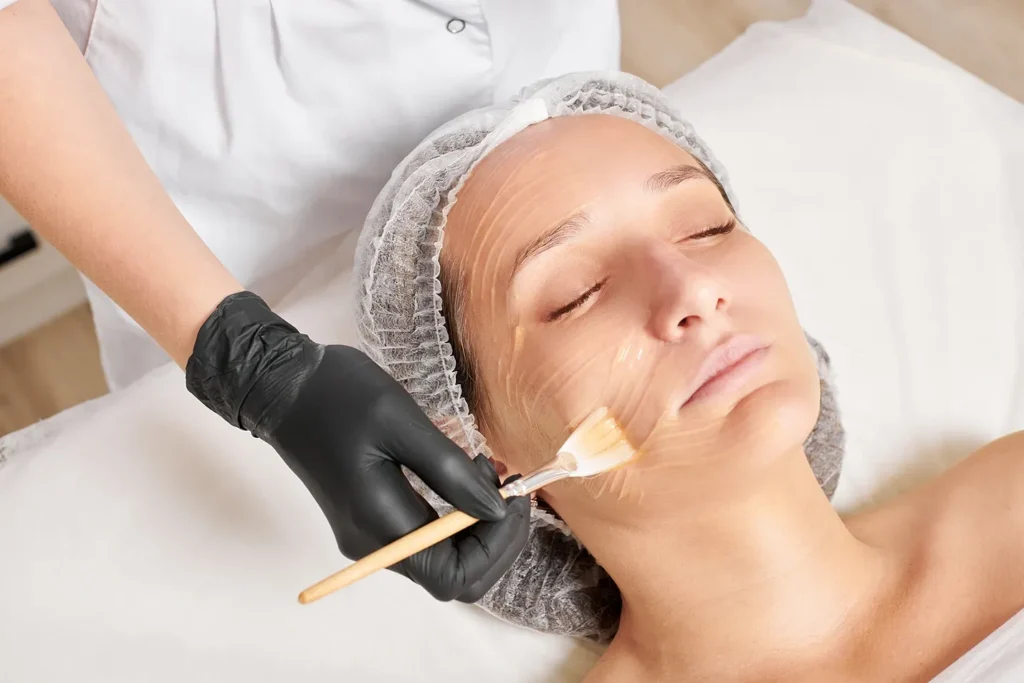Treatment Overview
The Hyperpigmentation Chemical Peel in Korea is a specialized MedSpa facial designed to target dark spots, uneven skin tone, and pigmentation issues while rejuvenating and brightening the skin. This advanced facial utilizes medical-grade chemical peel solutions to exfoliate the outer layer of the skin, stimulate cellular regeneration, and reduce melanin concentration in affected areas.
Korean clinics are internationally recognized for their cutting-edge chemical peel technology combined with expert dermatological care. The Hyperpigmentation Chemical Peel is particularly effective for sun-induced pigmentation, melasma, post-acne marks, and age spots, providing a non-invasive solution for clients seeking a more even, luminous complexion. With Korea’s focus on precision, safety, and innovation, this treatment offers reliable results for both domestic and international patients.
Purpose & Benefits
The primary goal of the Hyperpigmentation Chemical Peel is to lighten dark spots, even out skin tone, and rejuvenate the skin. The key benefits include:
- Reduces hyperpigmentation, dark spots, and post-inflammatory marks.
- Brightens and evens skin tone, giving a natural, radiant glow.
- Exfoliates dead skin cells, encouraging the growth of fresh, healthy skin.
- Stimulates collagen and elastin production, improving firmness and elasticity.
- Refines skin texture, minimizing rough patches and irregularities.
- Enhances absorption of serums and active ingredients, increasing overall skincare efficacy.
- Non-invasive and safe, suitable for most skin types with proper professional care.
This treatment is ideal for anyone struggling with stubborn pigmentation and seeking a safe, non-surgical solution for brighter, smoother skin.
Ideal Candidates
The Hyperpigmentation Chemical Peel is recommended for:
- Individuals with dark spots, melasma, or sun-induced pigmentation.
- Those with post-acne marks or uneven skin tone.
- People seeking improved skin texture, radiance, and overall appearance.
- Anyone looking for a non-invasive facial that effectively targets pigmentation and promotes healthy skin renewal.
This treatment may not be suitable for pregnant or breastfeeding women or individuals with active skin infections, eczema, or highly sensitive skin, unless approved by a dermatologist.
Possible Risks & Complications
The Hyperpigmentation Chemical Peel is generally safe, but temporary side effects may occur:
- Mild redness or tingling during or after the procedure.
- Peeling or flaking as the skin naturally exfoliates.
- Temporary dryness or tightness, which can be managed with proper moisturizing.
- Rarely, irritation or hyperpigmentation, particularly in very sensitive skin.
Korean clinics minimize these risks through personalized skin assessments, professional peel application, and soothing post-peel care.
Techniques Used
The Hyperpigmentation Chemical Peel follows a multi-step professional process:
- Deep Cleansing – Prepares the skin by removing oil, makeup, and impurities.
- Chemical Peel Application – A high-quality solution, often containing glycolic acid, lactic acid, mandelic acid, or salicylic acid, is applied to exfoliate and target pigmented areas.
- Neutralization & Rinse – The peel is neutralized to prevent over-exfoliation and ensure safety.
- Brightening Serum Infusion – Serums with vitamin C, niacinamide, peptides, and antioxidants are applied to calm, repair, and lighten the skin.
- Soothing Mask – A hydrating mask reduces irritation, replenishes moisture, and enhances the peel’s effectiveness.
- Moisturizer & Sunscreen – Protects the newly treated skin and supports recovery.
Sessions usually last 45–60 minutes, and treatment intensity is adjusted based on skin type and pigmentation severity.
Recovery & Aftercare
Recovery from the Hyperpigmentation Chemical Peel is typically minimal. Patients may experience mild peeling, redness, or dryness. Recommended aftercare includes:
- Using gentle cleansers and hydrating products.
- Avoiding direct sun exposure, harsh exfoliants, or retinoids for at least 48–72 hours.
- Applying broad-spectrum sunscreen daily to protect newly treated skin and maintain brightening effects.
- Avoiding scratching or picking peeling skin to prevent irritation or scarring.
Proper aftercare ensures optimal results and prevents complications.
Results & Longevity
Results are often noticeable after the first session:
- Reduction of hyperpigmentation and dark spots, with a more even complexion.
- Brighter, smoother, and more radiant skin.
- Improved skin texture and elasticity, giving a youthful appearance.
- Long-term benefits include sustained skin clarity and enhanced resistance to future pigmentation issues.
For best results, 3–6 sessions spaced 2–4 weeks apart are recommended, with quarterly maintenance treatments for ongoing skin brightness and health.
Treatment Process in Korea
Korean clinics are known for combining advanced chemical peel technology with personalized care and supplementary therapies. Enhancements in the Hyperpigmentation Chemical Peel include:
- Customized peel formulations tailored to target specific pigmentation types and skin sensitivity.
- Oxygen infusion therapy to boost nutrient absorption and accelerate skin regeneration.
- Combination therapies, including LED light therapy and ultrasonic treatments, to optimize results.
- Use of high-quality brightening serums and botanical extracts to enhance radiance and reduce irritation.
These innovations make Korea a top global destination for professional chemical peel treatments, particularly for pigmentation concerns.
Cost Range
The Hyperpigmentation Chemical Peel in Korea typically costs ₩200,000 – ₩450,000 KRW per session (approximately $160 – $350 USD), depending on the clinic, peel type, and any additional enhancements like oxygen infusion or LED therapy.
Popular Clinics
Some of the leading clinics offering this treatment include:
- Banobagi Dermatology – Known for personalized chemical peel facials and pigmentation-targeting solutions.
- Oracle Clinic – Offers advanced brightening and hyperpigmentation chemical peels.
- Lienjang Clinic – Specializes in innovative MedSpa treatments combining chemical peels with Korean skincare technology.
- ID Dermatology – Popular among international patients for safe and effective hyperpigmentation treatments.




